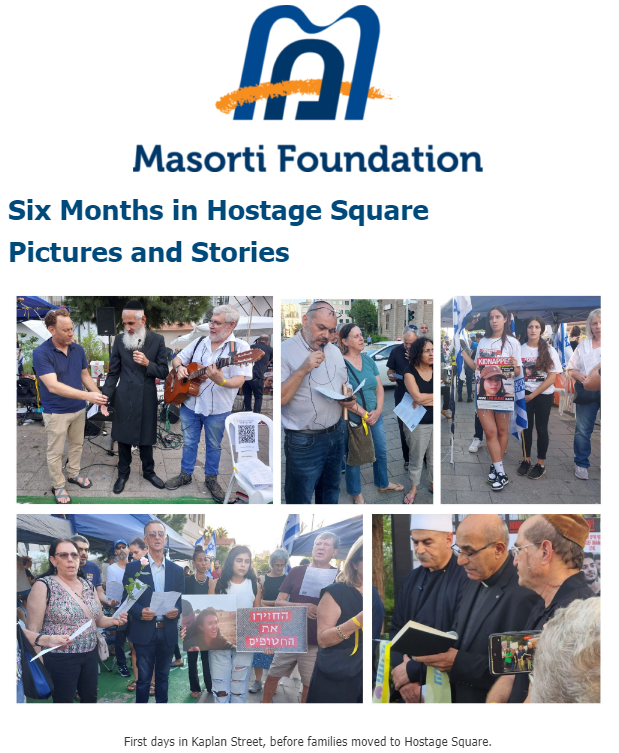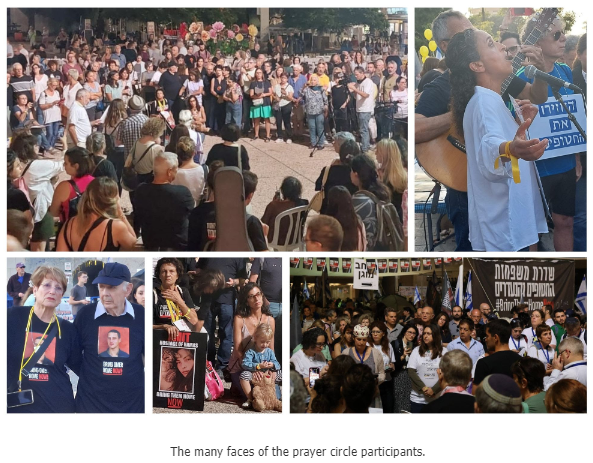When the Masorti Movement first entered Hostage Square, set up a few days after the initial shock of the October 7 atrocities, like all Israelis, we did not expect the site to become a routine part of our lives.
We asked ourselves, what is Masorti’s role, as a pluralistic religious movement, in these dark times. We understood that we had no choice but to do everything we could to hold the hope for the return of our hostages, in our own special way. This is how we created the prayer circle, in which we do not just invite all to take part, but actively seek out prayer leaders from all sectors of Israeli society.
A particularly special moment was when Rimon Kirsht, who had recently been released from Gaza, joined our prayer circle. Before her release, her mother could be found most days in the square, yet she only observed the prayer circle from afar. This time, Rimon’s mother approached Elisheva and, after the prayer circle embraced her with great warmth: “Thank you for helping bring back my daughter!”
Elisheva Barak, who organizes the daily prayer circles, recounts: “It was a chilling moment to hug Rimon, whom I had come to know from the banners, the stories, and her family. It’s hard to describe in words the power of such a moment, one I had longed for from the moment I first stepped into the square.”
Elisheva adds, “You don’t always get to see your prayers answered so tangibly before your eyes, but embracing Rimon and he mother, and feeling the excitement that gripped all those present, swept everyone into powerful and hopeful singing.”
We continue to be there, day after day, whatever the weather, in the square filled on one hand with sadness, yet on the other hand, sometimes glimmering with hope and prayer. We ensure that every day, no matter what, the prayers of the Jewish people, ascend from Hostage Square.
The consensus in Israel after Simchat Torah is that we must not return to the atmosphere of the months before the war. In Tel Aviv, at Hostage Square, a person can stand for an hour or two, gaze around and be convinced that this is indeed the case. Jews of all stripes – Conservative, Modern and Ultra-Orthodox, Reform and Secular – all naturally praying side by side.
“There’s no doubt that such scenes were very rare before Simchat Torah, and that’s a shame and very sad,” states Rakefet Ginsberg, Masorti’s CEO. “As a society, we must learn the lessons from the square. As a movement that flies the flag of pluralism, it is Masorti that has been able to bring together Jews from across the religious spectrum to pray together.”
One very moving occasion was during a visit to the square of a mission from Midway Jewish Center in Syosset, NY, the synagogue of lone soldier Omer Neutra, who is still held hostage in Gaza. Rabbi Joel Levenson and other synagogue members helped lead the prayer circle in the presence of Omer’s grandparents. They identify as Orthodox and often join the prayer circle, as well as meet with missions that Masorti brings to the square.
Another time, when Rabbi Sarah Cohen from Keturah was leading the prayer circle, she was joined by a group of Orthodox yeshiva students, who were on a country-wide tour to get better acquainted with Israeli society. The pain that had previously flowed from prevailing divisions is gradually being replaced by calls for peace, love and attempts at reconciliation.
The boys from the Orthodox yeshiva joined the minchah service, at the end of which all sang together the age-old prayer that today rends our heart more than ever:
Our brothers, the entire house of Israel, who are in distress and captivity, May the One above have mercy on them and bring them from distress to relief, from darkness to light, and from subjugation to redemption, immediately and in a timely manner.
Over the past six months, the prayer circle has transformed into a real community. Already in the early days, the sons of one of the hostages from the Nova party in Re’im began to regularly attend the prayer circle. Suddenly, they stopped coming.
When they returned after a while, in response to inquiries into their welfare from some of the regulars, one of them related that he had been hospitalized after a sudden stroke. The day after leaving hospital, he decided to come back to our prayer circle at Hostage Square. Another woman arrived and exclaimed, “Where did you disappear to? I was worried about you!”
And so, by chance, with no planning, a new community has been formed. Some people are regulars – family and friends of hostages, or members of the public who feel the need to identify with them – and some are one-time visitors, including many solidarity missions from abroad. We are able to connect these missions to the prayer circle participants by first facilitating a meeting with hostage family members, leading afterwards to a strong and meaningful active participation in the prayers and singing.
We hope that, in the very near future, this new kehillah will become obsolete and disperse itself, when our hostages are finally released. In the meantime, this very Jewish and Israeli “togetherness” is a source of comfort for many people during these times of trouble. This is why we continue to come and pray, every day, come what may, at Hostage Square.
Prayers
Downloads to recite at home, in your synagogue and at other gatherings:
Prayer for the Welfare and the Return of our Kidnapped Brothers and Sisters (Hebrew and English)
Updated list of hostages, to be used in prayers for their speedy and safe return (English – the list is continually being updated and includes names of all hostages who we believe to still be alive)
Prayer in Times of War – Fall 5784 (Hebrew and English)
















